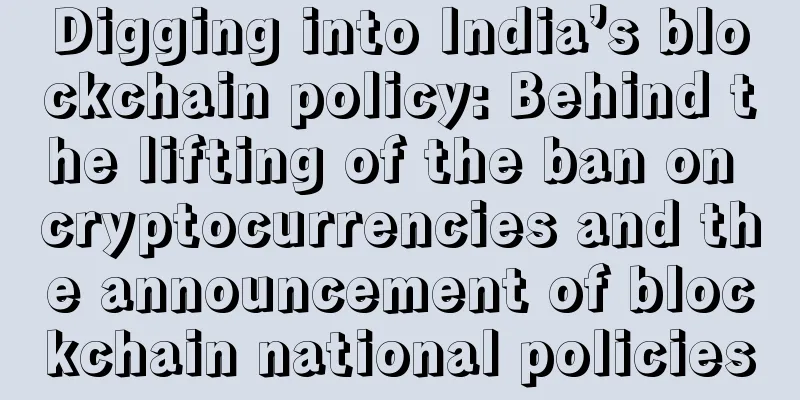Digging into India’s blockchain policy: Behind the lifting of the ban on cryptocurrencies and the announcement of blockchain national policies

India's central bank supports blockchain innovationAlthough the Reserve Bank of India issued a ban on the crypto industry in 2018, it is worth noting that in 2019 the Reserve Bank of India began to implement a financial sandbox policy to support blockchain innovation testing. On April 18, 2019, the Reserve Bank of India (RBI) released a report announcing the terms of its regulatory sandbox, which includes testing various blockchain applications, but does not include cryptocurrency-related projects. Previously, many countries in the world, including Singapore and the United Kingdom, have introduced financial sandbox policies to help financial technology companies conduct innovative tests involving a small number of consumers over a period of time. In 2016, the Reserve Bank of India began reviewing the sandbox framework to better respond to the "rapidly evolving" financial technology market dynamics. After three years of evaluation, the Reserve Bank of India believes that the public can try "innovative technologies" based on blockchain, and through the sandbox policy, the Reserve Bank of India has the opportunity to evaluate whether new regulations are needed to protect consumers. The RBI believes that blockchain companies and consumers will also benefit from the policy, as blockchain companies will “not need to spend expensive marketing efforts to test the feasibility of their products”, while the public will “reduce costs and improve access to financial services”. At the time, the RBI also made it clear that “innovators may lose some flexibility and spend more time due to the sandbox process” and that completing these tests does not mean that further regulatory approval is not required. The Reserve Bank of India has detailed a list of "innovative technologies" that have applied for sandbox testing, including blockchain platforms, mobile payment and digital identity software, data analysis, artificial intelligence or machine learning applications. In addition, industries that qualify as "innovative products and services" include retail payments, remittance services, digital know-your-customer checks, smart contracts and cybersecurity products. But at the same time, cryptocurrencies, crypto exchanges and ICOs are no longer within the scope of the sandbox test. In addition, products and services that have been banned by the Indian government or regulators are not eligible to apply. Previously, the Reserve Bank of India had also been planning to launch its own digital currency, but the planned release date was repeatedly postponed. India releases draft national blockchain policyJust earlier in February this year, India’s blockchain policy received another positive message. Image source network On February 3, according to Cointelegraph, the Indian government's policy think tank NITI Aayog released a draft national blockchain policy called "Blockchain-India Strategy", which describes the different uses of blockchain in India and summarizes ongoing pilot projects, aiming to formulate a specific national action plan for blockchain technology. The document is published in two parts. The first part covers basic concepts, smart contracts, the economic potential of blockchain, and use cases. The second part mainly covers specific recommendations for the use of blockchain technology in India. NITI Aayog explained that the fundamental features of blockchain technology could represent a paradigm shift in India’s political economy and stressed the need to rethink the current involvement of government agencies. “The government should pay special attention to decentralized networks where peer-to-peer transactions can create more social value. If state entities only maintain ledgers instead of adding value, then we can re-examine the role of the government.” Currently, NITI Aayog has conducted proof of concepts in four areas in an attempt to better understand the obstacles that may be encountered in implementing blockchain technology. According to reports, the pilot projects include drug tracking, claim verification and approval of fertilizer subsidy expenditures, verification of university certificates and transfer of land records. In addition, NITI Aayog pointed out that in order to deploy blockchain on a large scale, the private and public sectors need to amend some laws and regulations. Overall, after a period of strict prohibition, India's blockchain and crypto policies have gradually become more open and accepting. Previously, the ban by the Reserve Bank of India once became the biggest barrier to entry into the Indian crypto industry. Therefore, the ban was ruled invalid, which is undoubtedly very exciting news for the Indian crypto community. For global cryptocurrency investors, India may become the next hot spot for investment, because India's move will surely promote the prosperity of the crypto industry and further release the market potential of more than one billion people. |
<<: Analyst: Coronavirus will push Bitcoin price to $100,000 in 2020
Recommend
What does the left eyebrow twitching indicate?
Medically speaking, eyebrow twitching may be caus...
What does a birthmark on the back of your hand mean?
Most people have moles on their bodies to a great...
How to recognize people: How to recognize people by their walking posture
How to recognize people: How to recognize people ...
Ethereum Foundation dumps ETH again: How long can the foundation's funds last? Does Ethereum still have a future?
The Ethereum Foundation recently sold off ETH aga...
Is IPFS in Danger in 2020?
Previously, silent-observer wrote an article titl...
Is it okay for a woman to have a birthmark on the back of her neck?
Some people are born with birthmarks of varying s...
Mine owners talk about all aspects of park electricity
In May this year, at the mining conference held i...
[Video] Visiting Xinjiang Bitcoin Mine
Visiting Xinjiang Bitcoin Mine (Video: Visiting X...
Do you have a lucky mole? Where does good luck grow?
1. Mole at the end of eyebrow A mole at the end o...
Coinbase CEO: Bitcoin and other digital currencies will become the world's reserve currency
On May 25, at the Token Summit held at the New Yo...
What are the types of fingerprints?
Among the ten fingers of a person, not only can y...
The uglier these parts are, the better your luck will be.
Every man desires to be tall, rich and handsome, ...
The most typical facial features of men who cheat: men who cheat actually look like this
Nowadays, many men love to cheat. They are unfait...
How to read your fortune from your fingers
How to read your fortune from your fingers Hands ...
According to face reading, people with certain face readings will always have good luck.
Physiognomy, what kind of people will have good l...









